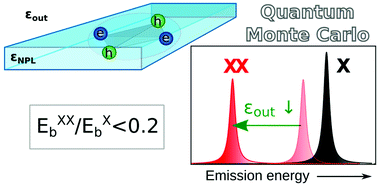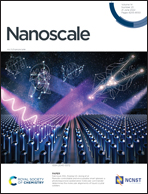Biexcitons in CdSe nanoplatelets: geometry, binding energy and radiative rate†
Abstract
Biexciton properties in semiconductor nanostructures are highly sensitive to quantum confinement, relative electron–hole masses, dielectric environment and Coulomb correlations. Here we present a variational Quantum Monte Carlo model which, coupled to effective mass Hamiltonians, takes into account all of the above effects. The model is used to provide theoretical assessment on the biexciton ground state properties in colloidal CdSe nanoplatelets. A number of characteristic features is observed: (i) the finite thickness of these systems makes the biexciton geometry depart from the planar square expected in the two-dimensional (2D) limit, and form a distorted tetrahedron instead; (ii) the strong dielectric confinement enhances not only Coulomb attractions but also repulsions, which lowers the ratio of the biexciton-to-exciton binding energy down to EXXb/EXb = 0.07. (iii) EXXb is less sensitive than EXb to lateral confinement, and yet it can reach values above 30 meV, thus granting room temperature stability; (iv) the ratio of biexciton-to-exciton radiative rates, kradXX/kradX, decreases from 3.5 to ∼1 as the platelet area increases. These results pave the way for the rational design of biexciton properties in metal chalcogenide nanoplatelets.



 Please wait while we load your content...
Please wait while we load your content...